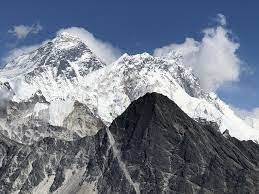Seventy years ago, on May 29, 1953, New Zealand mountaineer Edmund Hillary and Nepali Sherpa Tenzing Norgay became the first humans to reach the summit of the mountain known as Everest. The successful British expedition made them household names worldwide and had a profound impact on the world of mountaineering.
Originally identified by British mapmakers as Peak XV, the mountain was later named Everest in 1865 after Sir George Everest, a former Surveyor General of India. It is situated on the border of Nepal and China and is referred to as Chomolungma or Qomolangma in Sherpa and Tibetan, meaning “goddess mother of the world,” and as Sagarmatha in Nepali, meaning “peak of the sky.”
The climbing of Everest has evolved significantly since the 1953 expedition. It took 20 years for the first 600 people to reach the summit, but now hundreds of climbers attempt it each year. The journey to the base camp has been shortened to eight days with the introduction of a mountain airstrip in Lukla in 1964. Advancements in gear, oxygen supplies, and tracking devices have made expeditions safer, and experienced Nepali guides now set the route for paying clients.
Everest Base Camp, the starting point for climbs, has transformed from a collection of tents to a more developed area offering amenities such as fresh food, wifi, and modern communication devices.
The transmission of news about summit achievements has also changed. In the past, news of Hillary and Tenzing’s successful ascent took several days to reach the outside world. Nowadays, climbers can communicate with their base camp teams using walkie-talkies or smartphones and share updates on social media. In 2020, China even introduced 5G connectivity at the Everest summit.
Climate change has had an impact on Everest, with rising temperatures widening crevasses and causing glacial melting. The Khumbu glacier, in particular, has shown vulnerability to warming temperatures. Climbers and expedition companies have started implementing eco-friendly practices, including the use of solar power, to mitigate their impact on the mountain’s environment.
Social media has become an integral part of the Everest experience, with climbers documenting their journeys on platforms like Facebook and Instagram. This not only allows them to share their experiences but also attracts sponsors and potential funders. Even Nepali guides have embraced social media to build their profiles and share their achievements.
Everest has witnessed various records and remarkable feats. Veteran Nepali guides Kami Rita Sherpa and Pasang Dawa Sherpa have both scaled Everest multiple times, with Kami Rita currently holding the record with 28 summits. Beyond climbing records, there have been unique endeavors, such as the highest dinner party held by a team of climbers at 7,056 meters on the mountain’s Chinese side.
Seventy years after Hillary and Tenzing’s historic achievement, Everest continues to captivate adventurers, challenge climbers, and raise concerns about overcrowding and environmental impact.
